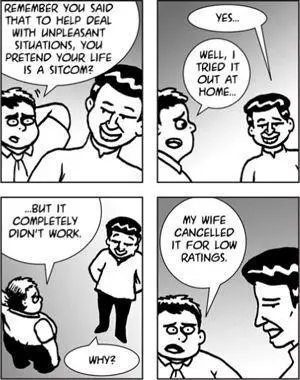Tan, Chade-Meng - Search Inside Yourself - The Unexpected Path to Achieving Success, Happiness (and World Peace)
Здесь есть возможность читать онлайн «Tan, Chade-Meng - Search Inside Yourself - The Unexpected Path to Achieving Success, Happiness (and World Peace)» — ознакомительный отрывок электронной книги совершенно бесплатно, а после прочтения отрывка купить полную версию. В некоторых случаях можно слушать аудио, скачать через торрент в формате fb2 и присутствует краткое содержание. Год выпуска: 2012, Издательство: Harper Collins, Inc., Жанр: Старинная литература, на английском языке. Описание произведения, (предисловие) а так же отзывы посетителей доступны на портале библиотеки ЛибКат.
- Название:Search Inside Yourself: The Unexpected Path to Achieving Success, Happiness (and World Peace)
- Автор:
- Издательство:Harper Collins, Inc.
- Жанр:
- Год:2012
- ISBN:нет данных
- Рейтинг книги:4 / 5. Голосов: 1
-
Избранное:Добавить в избранное
- Отзывы:
-
Ваша оценка:
- 80
- 1
- 2
- 3
- 4
- 5
Search Inside Yourself: The Unexpected Path to Achieving Success, Happiness (and World Peace): краткое содержание, описание и аннотация
Предлагаем к чтению аннотацию, описание, краткое содержание или предисловие (зависит от того, что написал сам автор книги «Search Inside Yourself: The Unexpected Path to Achieving Success, Happiness (and World Peace)»). Если вы не нашли необходимую информацию о книге — напишите в комментариях, мы постараемся отыскать её.
Search Inside Yourself: The Unexpected Path to Achieving Success, Happiness (and World Peace) — читать онлайн ознакомительный отрывок
Ниже представлен текст книги, разбитый по страницам. Система сохранения места последней прочитанной страницы, позволяет с удобством читать онлайн бесплатно книгу «Search Inside Yourself: The Unexpected Path to Achieving Success, Happiness (and World Peace)», без необходимости каждый раз заново искать на чём Вы остановились. Поставьте закладку, и сможете в любой момент перейти на страницу, на которой закончили чтение.
Интервал:
Закладка:
Let’s take a minute to experience the physiology of emotion in the body.
(60-second pause)
Now we reflect.
Where is the emotion coming from? Is there a history behind it? If this experience involves another person, put yourself inside the other person looking out at you. Think about this statement: “Everybody wants to be happy. This person thinks acting this way will make him happy, in some way.” Bring perspective without judging it to be right or wrong.
(30-second pause)
Now we respond.
Bring to mind ways in which you might respond to this situation that would have a positive outcome. You do not actually have to do it—just imagine the kindest, most positive response. What would that look like? Let’s spend the next minute or so creating that response.
(60-second pause) Returning to Grounding
Let us now return to the present for 2 minutes. Bring awareness back to your breath.
(Short pause)
Make a tight fist with your hand, holding any of your residual emotion there. Slowly open your fingers and let go of that energy.
And bring your attention back, either to your body, or your breath, whichever your mind finds more stability in.
And just settle your mind there, for the remainder of 1 minute.
In class, right after the above exercise, we always do Mindful Conversation (see Chapter 3) in pairs to give everyone a chance to process the experience. Those who are comfortable doing so may tell their stories and share their experiences. Those who are not comfortable doing so may just talk about how it felt to go through the process itself.
In this artificial setting, the five-step process takes seven minutes. In real life, the whole process may be over in seconds, which may not give you a lot of time to do it right if you do not have sufficient practice. One way to practice this process is to do it retroactively. That means practicing the reflection and response steps after a triggering event is over. The first three steps (stop, breathe, notice) can be strengthened with sitting mindfulness practice. The last two steps (reflect and respond) are best strengthened with real-life cases. Given how quickly each episode moves, it’s hard to train in real time, but it’s just as effective to do it “off-line” retroactively. The more time you spend practicing the reflect-and-respond process offline, the better you will be able to do it in the real-life situation.
The next time you are triggered, remember to take the SBNRR.

“Good news, comrades! To help you deal with negative or distressing emotions, the Politburo has come up with a handy mnemonic…”
How to Not Strangle Your Mother-In-Law
Derek, one Search Inside Yourself participant who had no prior mindfulness training, told me this story:
My mother-in-law forgot to engage the brake on the stroller with my twenty-month-old daughter inside. The stroller went sailing across the driveway, smacking into one of our cars. Thanks to Search Inside Yourself, instead of coming unglued and saying something stupid, I took two deep breaths and simply refrained from comment. Better still, I did it almost without thinking about it, I just brought attention to my breath at my nostrils, and it just worked. I even recognized the racing in my heart and the sinking, gross feeling in my stomach. It was amazing .
If you ever need examples of people with crazy tempers (me), who usually engage mouth before brain, being able to successfully employ Search Inside Yourself training to not strangle their mothers-in-law, you may tell my story .
Derek did not just refrain from doing something stupid at the moment, but he was also able to later reflect on how sorry his mother-in-law must have felt, and he forgave her carelessness with a few kind words. Last I heard, they lived happily ever after. (Derek’s name has been changed to protect him from mothers-in-law.)
Other Ways to Handle Triggers
One way of looking at the Siberian North Railroad approach is as an emotional self-regulation strategy, starting with attentional control and resulting in cognitive change over time. If you understand it that way, it can become a general framework on which we can add other ways of handling triggers. This idea was suggested to me by Philippe Goldin who was, in turn, inspired by a review paper by Kevin Ochsner and James Gross. 5
As you see below, the timeline begins with the triggering event and goes from left to right. We begin with attentional control but move increasingly toward cognitive change.

In attentional control, during the moments right after being triggered, we recommend to stop, breathe, and notice, which corresponds to calming the mind and observing the emotional experience in the body. In addition to those, there are other things you can try that may work better for you. One is the standard practice of counting to ten, which is a more deliberate way of invoking the sacred pause. This practice also has the benefit of giving your mind something else to do, thus temporarily distracting it from emotions until it is capable of handling the situation. Another practice is to take slow, deep breaths. Taking deep breaths induces a calming effect, possibly because it stimulates the vagus nerve, which is known to reduce heart rate and blood pressure (I imagine it must be the opposite of the Las Vegas nerve). Lastly, if it gets too overwhelming, you can temporarily distract yourself totally by focusing on something entirely unrelated to the trigger, such as staring at reading materials you have at hand, or perhaps excusing yourself from the room by taking a restroom break (“Break free, go pee”).
Attentional control is good and necessary, but often insufficient. Even if your mind is so highly trained that you can let go of the distress and return to calm very quickly, the issues behind the trigger will remain unresolved and you will still be similarly triggered in the future. Hence, cognitive work is also necessary. Cognitive work here means reframing and reinterpreting the meaning of the situation. It almost always involves seeing things more objectively and with more compassion toward self and others. The cognitive practices we recommend are to reflect and respond, which are reflecting on how this trigger connects with your own past and how it must seem from the other person’s point of view, and deciding what your optimal response would be if you had a choice.
In addition to these, if it works for you, you can also try seeing positives in this trigger. For example, you just blew up in front of your new boyfriend and are surprised at the level of emotion. This is a perfect time to let things calm down and create space so you can both talk about it, using the situation as an opportunity to help him know you more deeply as a person. Or perhaps this is an opportunity for self-discovery. For example, if you already have a mature meditation practice and something your boss says suddenly makes you feel very vulnerable (“like I’m five years old again”), you have just received valuable education on which aspects of your meditation practice you need to focus. Finally, a more advanced but highly effective practice is to apply kindness and compassion in the situation. This is something we will explore in Chapters 7 and 8.
The final piece of the framework is creating a willingness to experience and accept the emotions—in a way, opening up the heart and mind so they become big enough to effortlessly contain any emotion, like the sky effortlessly containing any cloud. We suggest two practices for this. The first is something Marc Lesser calls “meshing,” or visualizing yourself as porous as a mesh screen. As you encounter strong feelings welling up (for example, anger, resentment, fear), let these feelings pass through your body. You can observe these intense feelings moving through you, not sticking to you, and see that they are separate from you. The second, which is my own practice, is to pretend my life is a sitcom and appreciate the humor in every absurd situation. In my life, I have found myself in many unpleasant situations, and most of them can be scenes in a bad comedy, especially bad situations of my own making.
Читать дальшеИнтервал:
Закладка:
Похожие книги на «Search Inside Yourself: The Unexpected Path to Achieving Success, Happiness (and World Peace)»
Представляем Вашему вниманию похожие книги на «Search Inside Yourself: The Unexpected Path to Achieving Success, Happiness (and World Peace)» списком для выбора. Мы отобрали схожую по названию и смыслу литературу в надежде предоставить читателям больше вариантов отыскать новые, интересные, ещё непрочитанные произведения.
Обсуждение, отзывы о книге «Search Inside Yourself: The Unexpected Path to Achieving Success, Happiness (and World Peace)» и просто собственные мнения читателей. Оставьте ваши комментарии, напишите, что Вы думаете о произведении, его смысле или главных героях. Укажите что конкретно понравилось, а что нет, и почему Вы так считаете.







![Chade-Meng Tan - Search Inside Yourself - Increase Productivity, Creativity and Happiness [ePub edition]](/books/703803/chade-thumb.webp)



